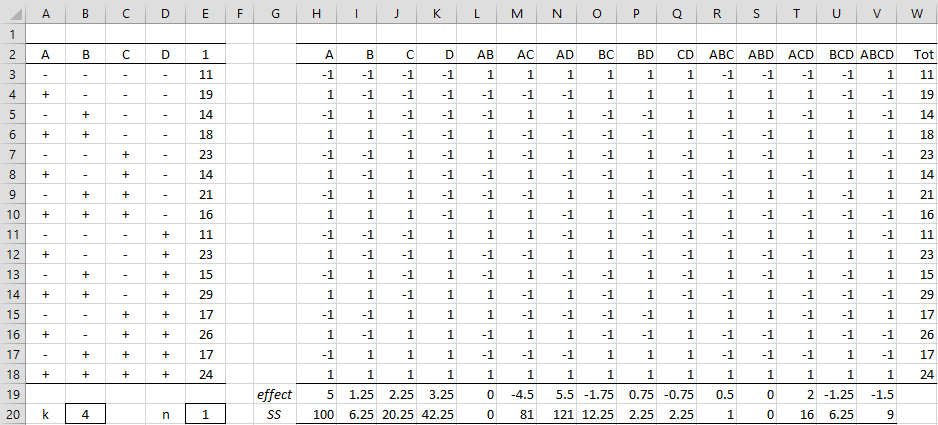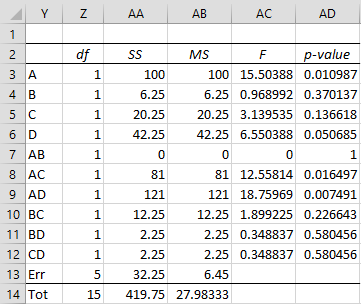Basic Concepts
For designs without replications, we need to pool some of the interaction factors into the error term. We have a number of choices for how we do this, but we avoid including interaction factors in the error whose effect size are outliers since this will inflate the MSE value. We can use any of the techniques described on the rest of this website to determine which factors are outliers (i.e. their effect size is an outlier compared to the effect sizes of all the factors).
Example
Example 1: Create the 2^4 factorial design for the data in range A2:E18 of Figure 1.
Figure 1 – Design without Replications
We construct the effect size and SS values exactly as we did for Example 1 of 2k Factorial Design Basic Concepts. These values are shown in range H19:V20 of Figure 1.
We pool the 3rd and 4th order interaction factors to make up the error term. Note that the extreme values for the effect sizes are 5.5 (AD) and -4.5 (AC). None of the 3rd and 4th order interaction factors have effect sizes anywhere near these extreme values and so we don’t need to worry about inflating the MSE value (in fact, if we use the Box Plot with Outliers, Grubbs’ Test or Outliers and Missing Data options of the Descriptive Statistics and Normality Test data analysis tool, we will see that no potential outliers are flagged).
ANOVA
Constructing the ANOVA table as we did for Example 1 in 2^k Factorial Design Basic Concepts, we get the analysis shown in Figure 2.
Figure 2 – Design without Replications (design 1)
We see that factors A, AC, AD are significant and D is borderline.
Note that no factor containing B is significant and so another approach is to eliminate factor B from the analysis. This is equivalent to a 2^3 factorial design with n = 2 replications (e.g. A = +, C = +, D = – has replications 14 and 16). The analysis for this design is shown in Figure 3.
Figure 3 – Reduced design (design 2)
This time, factors A, D, AC, and AD are significant.
Examples Workbook
Click here to download the Excel workbook with the examples described on this webpage.
References
PennState (2017) Unreplicated 2k factorial design
https://online.stat.psu.edu/stat503/lesson/6/6.3
Montgomery, D. C. (2012) The 2k factorial design. Design and analysis of experiments, 8th ed.
https://faculty.ksu.edu.sa/sites/default/files/douglas_c._montgomery-design_and_analysis_of_experiments-wiley_2012_edition_8.pdf



Dear Charles,
Thank you for the resources, they’ve been a big help in refreshing my (very rusty) knowledge on DoE. I have been able to obtain the equation for y=ß0+ßaA+ßbB…
Regarding the regression analysis however, it is not explained here or in the Basics page what you’re doing your regression *against*. Apologies if that seems to be something obvious, but since I cannot instal the Real Stats addon (i’m on a work PC which does not give me permissions), I’m left fumbling with some of the tools.
Thanks again for this step-by-step!
Best regards,
M. Cerveau.
Hello,
Regression analysis is explained at
https://real-statistics.com/regression/
https://real-statistics.com/multiple-regression/
Regarding using regression to address ANOVA, perhaps one of the following will be helpful:
https://real-statistics.com/anova-using-regression/
https://real-statistics.com/unbalanced-factorial-anova/
https://real-statistics.com/anova-repeated-measures/repeated-measures-anova-using-regression/simple-repeated-measures-anova-using-regression/
Charle
Hello Charles,
Is there 2k factorial design examples in the workbook? Thank you
Daniel
Yes. All the examples on the website are in the examples workbooks.
Charles